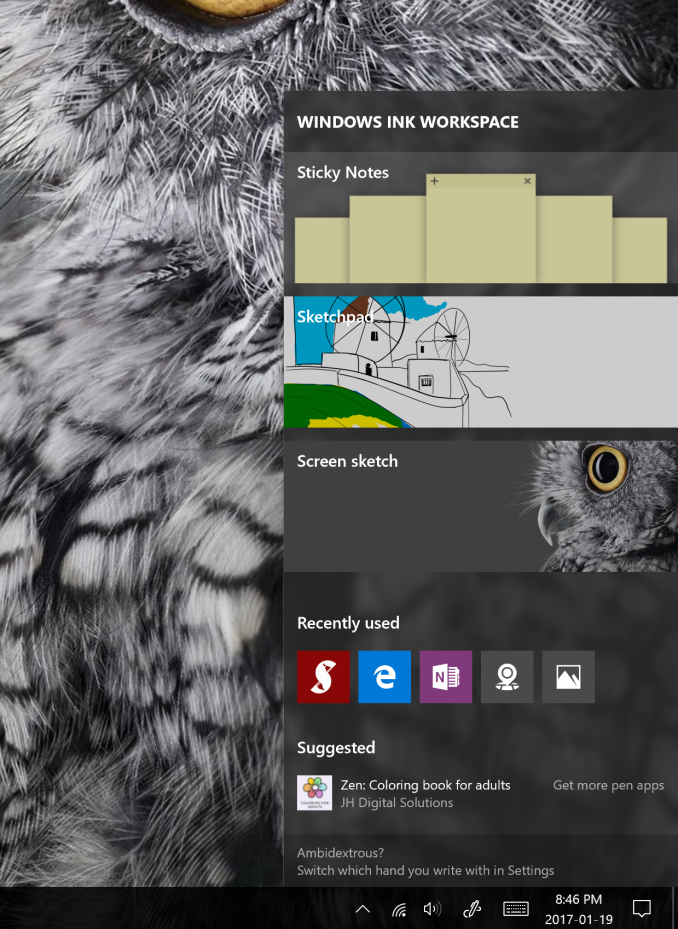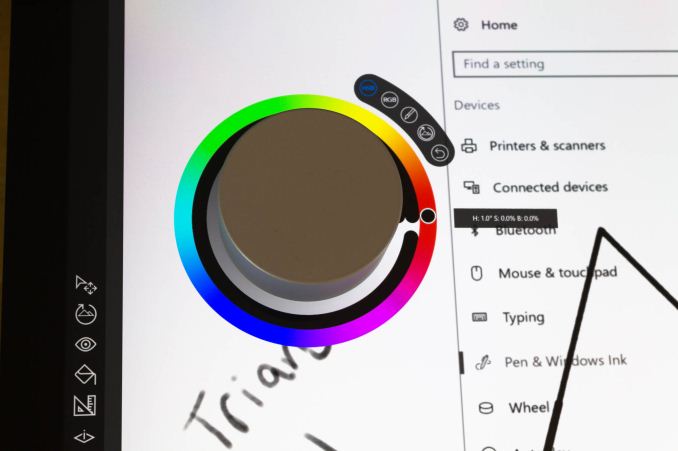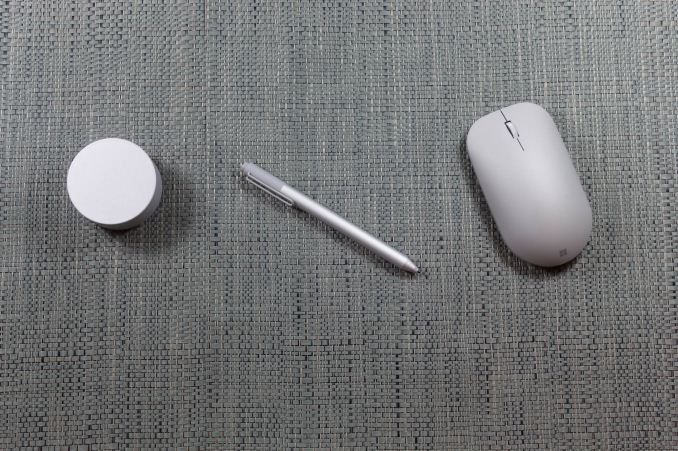The Microsoft Surface Studio Review
by Brett Howse on January 20, 2017 8:00 AM EST- Posted in
- Desktop
- Microsoft
- Surface
- Surface Studio
Final Words
Microsoft’s Surface Studio is arguably the most exciting desktop to launch in a long time. The world has been moving to more portable devices for a while now, with notebook sales overtaking desktops and never looking back. There certainly is an appeal to a large screen desktop though, and for anyone that needs to get a lot done, it’s easy to see why a desktop can make this a more enjoyable experience. The idea of the desktop has been changing for some time though. All-in-one PCs are very popular due to the simplicity of setup, and aesthetics. You no longer need a beige box in the corner powering your office, and small form factor devices like Intel’s NUC have been a strong category in a down market.
Microsoft is targeting creative designers with the Surface Studio, a job that is made much easier thanks to the clever zero-gravity hinge system, and the Studio’s ability to fold down into a drafting table. The massive screen offers a lot of surface area for use with the Surface Pen, and it was no accident the Studio launched at the Windows 10 Creator’s Update event in late October. The Surface Studio is a halo product in this niche, promising a great experience for digital makers. How well it delivers depends on your particular needs, but there is a lot of great aspects to the Surface Studio.
Let’s start with the display, which is the key feature of the entire product. Microsoft has aggressively pursued display improvements with the Surface line, right from the time it was first announced. It has taken a couple of generations of Surface for them to get to where I think they wanted to be, but with the Surface Studio, they’ve really dealt a royal flush. The 28.125-inch display, with 13.5 million pixels, perfectly fits the 200% scaling level meaning items on-screen are the exact right size. Since they are not using any sort of fractional, non-integer scaling, the end result is a display that is incredibly sharp, but with less issues with fonts and the like. High DPI can still be an issue in Windows 10, depending on the applications you run, but it is generally a great experience.
Microsoft decided to cover three different color gamuts on the Surface Studio, with sRGB, DCI-P3, and P3 D65. The only mistake they made was naming P3 D65 “Vivid” mode, which is confusing and non-obvious. Their per-device calibration is spot on, with the Surface Studio being one of the most accurate displays we have ever tested, especially without prior calibration. Out of the box, it is likely one of the most accurate displays on a consumer level device, and it is incredibly accurate in all three color gamuts. Windows 10 itself needs to do a better job with color spaces though. Having an on-screen toggle to choose the color space you want to use is a very usable method of switching, but the Studio owner should not need to do this manually. Despite the high level of accuracy, if someone chooses the wrong color gamut for their content, it is likely to be showing the wrong colors, unless the application itself is color managed, and most are not.
Other than the display, the other stand-out feature of the Surface Studio is the design. With an all-aluminum chassis and display, it looks and feels as premium as it should. The display is only 12.5 mm thick, which Microsoft claims is the thinnest ever designed for this type of device. The proportions of the Studio, with it’s 3:2 display, chrome arms, and PC base, all make it feel like a single cohesive design. The design pays homage to other Surface designs too, with the same type of vent ridge along the top of the base, and it of course is finished in the Surface gray that has become a signature too.
The keyboard and mouse that ship with the Surface Studio also fit well into this design, but the new ergonomic option adds a premium feel with an Alcantara wrist rest. The Surface Pen is the same pen that shipped with the Surface Pro 4 and Surface Book, and it offers a great writing experience, and swappable pen tips. You can customize the sensitivity of the pen as well to suit your own writing style, and the eraser on the top is a nice touch, and it doubles as a clickable button to invoke the Windows Ink Workspace and other programs. Windows 10 has come a long way in terms of pen support, and the forthcoming Creator’s Update will add even more features. The Surface Dial is a very interesting concept, and is well executed. Software support is going to be the key to see if it takes off, but it could be a very popular device with digital artists.
The computer side of the Surface Studio is entirely laptop class parts, with a 45-Watt Intel Skylake CPU, and NVIDIA GTX 965M or GTX 980M GPUs. The choice of a Skylake CPU, rather than wait several months for Intel to release the quad-core Kaby Lake parts, is fine. Kaby Lake is completely a process change, and has no IPC gains over Skylake anyway. The choice to use NVIDIA’s previous generation Maxwell GPUs though was an unsatisfying one, especially considering the resolution of the display. The GTX 980M handles desktop duties just fine, but if you do want to stretch its legs with some games, it really can’t be used much higher than 1920x1080, except on a few select titles like Dota 2. The latest Pascal parts offer more than just gaming performance too, with a lower power consumption, and possibly a cooler, and quieter, Surface Studio. It would have taken some last second effort to redesign the mainboard and cooling to accommodate the Pascal GPUs, but the end result would have been worth it.
The other main issue is the hybrid hard drive as the only storage option. People with desktops may not be ready for smaller SSDs as the boot drive, but it would have been nice to see even a single model of Surface Studio offer a SSD-only (or SSD boot drive) option. My experience with the hybrid drive on the Surface Studio was better than I expected though, and most of the time it was not an issue. There were certain tasks though that clearly ended up hitting the hard drive, and it’s a slow 5400rpm model as well.
The system noise at load is excellent, at just 46 dB, but the system noise at idle is a bit too loud for my tastes. My desktop systems tend to be silent unless heavily loaded, so listening to the fan all the time of the Surface Studio was tiring.
Now let’s talk about pricing and models. The base model starts at $2999, and offers a Core i5-6440HQ and GTX 965M. That is fine, but the 8 GB of RAM is not really enough for a $3000 desktop PC, and since it is soldered on, it can never be upgraded. The base model also features just a 64 GB SATA SSD for the caching drive, and therefore the base model should be avoided if you are looking at the Surface Studio. This is an expensive device, and 8 GB of RAM and a poor storage solution is always going to be a burden. Realistically, the $3499 mid-level model is really the only reasonable place to start shopping for a Surface Studio. For the extra money, the CPU gets bumped to a Core i7-6820HQ, and even more importantly the RAM is doubled to 16 GB, and the caching drive is doubled to 128 GB. The $4199 price tag on the top model is a tough pill to swallow, but the GTX 980M is a big jump up from the GTX 965M, and you also get 32 GB of RAM and a 2 TB hybrid drive. It’s not an inexpensive jump in price though, on an already expensive computer.
The price on the Surface Studio is going to deter many people, but the Surface line seems to be more about offering a product that showcases the best of Windows 10, and Microsoft is leaving enough room for other manufacturers to come into the category as well. That has worked very well for them with the Surface Pro 4, and already at CES, Dell was showcasing their own Dell Canvas display, offering much of the same ideas as the Surface Studio, but without the insanely high resolution, build quality, and most importantly, price. In spite of the high price, Surface Studio stock is in short supply, with the device sold out at both the Microsoft Store and retail partner Best Buy, with ship esitimates up to six months out for the top end model. The Surface Studio is not perfect, and it’s very expensive, but it’s hard not to want one.














197 Comments
View All Comments
Devo2007 - Friday, January 20, 2017 - link
With all the bugs of the Surface Pro 4 tablet and Surface Book, I wouldn't call either of them among the best. As for the Surface Studio, it is aimed at such a niche audience that it will probably be quite some time before we see any major issues pop up, but I won't be surprised when (not if) they do.ingwe - Friday, January 20, 2017 - link
I have a Surface Pro 4 for work and it locks up at least once a day. Sometimes it doesn't recognize the type cover that I have. It took me a while to sort out the battery drain issue while it was sleeping. It frequently locks up while restarting. Literally the exact hardware that I want and the software just seems to be so buggy. It's a real shame.BurntMyBacon - Friday, January 20, 2017 - link
That's a shame. I would've hoped it would behave more like the Surface Book given the same software and similarities in the hardware.I haven't had any issues with my Surface Book thus far that weren't a result of my own software and configuration choices. No lockups at all to this date. Some quirky behavior with Edge early on that got fixed with updates (All Win10 devices?). Abnormal pauses were reproducible on a desktop Win10 system and I've adjusted my configuration to eliminate this issue on both. Games work well enough despite not getting the latest nVidia drivers. My uncle said he had some issues with his early on, but it didn't take them long to resolve them.
I'll have to keep in mind that the Surface Pro 4 experience isn't necessarily the same as the Surface Book experience.
nikon133 - Sunday, January 22, 2017 - link
In my experience, Surface Pro 3 is much more stable platform than Surface Pro 4.Had a chance to use both, actually switch between SP3 and SP4 a few times. On paper, SP4 would be my choice - less heat, less fan activity, slightly bigger, better, higher res screen... a bit lighter, too.
However... I had chance to play with two SP4. One was repaired/refurbished, the other one brand new. Solid 5 months in-between, so they couldn't be same batch. Both SP4 exhibited touch-screen issues... at some point, every couple of days or so, screen would stop reacting to touch. Type cover would work. Reboot later, touch screen is back, no errors in event log to point to driver crashing or any other observable problem. This was kind of "fixed" at some point, where touch-screen would stop reacting, and then start reacting on its own, after a few seconds, as if Windows was restarting touch-screen tech/software automatically on detected problem, so no need to restart whole Surface... basically more of a workaround than real fix. Refurbished one also had problem with Halo - face recognition was a bit of hit-and-miss, even under good light. Seemed to be very sensitive to distance between camera and face, as if DoF was really shallow. The new one was much more reliable with Halo tech (software updates that were released in the meantime, or refurb had somehow flawed Halo hardware?). Both SP4 had a bit of an issue with my LinkSys ADSL modem/router which I also used as wireless AP. Arguably that part might have been down to ADSL device, but then again - two SP3 I have been using had none of these issues.
mr_tawan - Wednesday, January 25, 2017 - link
My SP3 does not detect the type cover quite often. Not really sure if it's physical damage or software issue though. I'm considering getting a cheap chinese cover which runs on bluetooth instead of the i2c interface. Even if the connector is damaged, the keyboard should still works (downside is I have to recharge the keyboard once in a while, and have to turn it on or off manually)Other than that my SP3 runs pretty solid, although the GPU is pretty much underpowered.
mr_tawan - Wednesday, January 25, 2017 - link
Oh and since my keyboard is out of warrantee now, getting a replacement is almost the same price as buying a new one.swaaye - Friday, January 20, 2017 - link
The only problem I've had with my Surface Pro 4 is screen flicker when it's at low brightness. It's only a problem in a dark room when brightness is about 10%. But yeah I have heard about all the other issues people have seen with them.Samus - Friday, January 20, 2017 - link
We had a lot of problems with a whole batch of Surface 3's at a law office. Eventually Microsoft agreed to swap them all for Surface 4's. Problems from battery performance to two of them just outright dying.vLsL2VnDmWjoTByaVLxb - Friday, January 20, 2017 - link
On my Fourth Surface Book since buying one pre-order back in October 2015. I need to turn it in for a fifth one later this month. The device(s) have never worked to my satisfaction. The first three suffered from graphical glitches, crashes, wakeup oddities, and strange glitches. The one I'm on now will randomly have the keyboard/mouse stop functioning after waking up, inability to wake up, and the hinge is "loose" so that the Surface Book frequently thinks it is detached/reattached. So tired of dealing with this thing.damianrobertjones - Friday, January 20, 2017 - link
Then get a refund and perhaps move on? After the second I'd have asked for a refund or sold it.